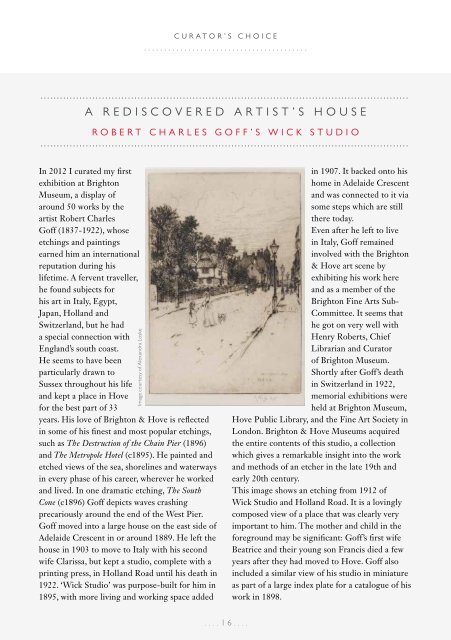Viva Brighton Issue #63 May 2018
You also want an ePaper? Increase the reach of your titles
YUMPU automatically turns print PDFs into web optimized ePapers that Google loves.
CURATOR’S CHOICE<br />
.........................................<br />
A REDISCOVERED ARTIST’S HOUSE<br />
ROBERT CHARLES GOFF’S WICK STUDIO<br />
In 2012 I curated my first<br />
exhibition at <strong>Brighton</strong><br />
Museum, a display of<br />
around 50 works by the<br />
artist Robert Charles<br />
Goff (1837-1922), whose<br />
etchings and paintings<br />
earned him an international<br />
reputation during his<br />
lifetime. A fervent traveller,<br />
he found subjects for<br />
his art in Italy, Egypt,<br />
Japan, Holland and<br />
Switzerland, but he had<br />
a special connection with<br />
England’s south coast.<br />
He seems to have been<br />
particularly drawn to<br />
Sussex throughout his life<br />
and kept a place in Hove<br />
for the best part of 33<br />
years. His love of <strong>Brighton</strong> & Hove is reflected<br />
in some of his finest and most popular etchings,<br />
such as The Destruction of the Chain Pier (1896)<br />
and The Metropole Hotel (c1895). He painted and<br />
etched views of the sea, shorelines and waterways<br />
in every phase of his career, wherever he worked<br />
and lived. In one dramatic etching, The South<br />
Cone (c1896) Goff depicts waves crashing<br />
precariously around the end of the West Pier.<br />
Goff moved into a large house on the east side of<br />
Adelaide Crescent in or around 1889. He left the<br />
house in 1903 to move to Italy with his second<br />
wife Clarissa, but kept a studio, complete with a<br />
printing press, in Holland Road until his death in<br />
1922. ‘Wick Studio’ was purpose-built for him in<br />
1895, with more living and working space added<br />
Image courtesy of Alexandra Loske<br />
in 1907. It backed onto his<br />
home in Adelaide Crescent<br />
and was connected to it via<br />
some steps which are still<br />
there today.<br />
Even after he left to live<br />
in Italy, Goff remained<br />
involved with the <strong>Brighton</strong><br />
& Hove art scene by<br />
exhibiting his work here<br />
and as a member of the<br />
<strong>Brighton</strong> Fine Arts Sub-<br />
Committee. It seems that<br />
he got on very well with<br />
Henry Roberts, Chief<br />
Librarian and Curator<br />
of <strong>Brighton</strong> Museum.<br />
Shortly after Goff’s death<br />
in Switzerland in 1922,<br />
memorial exhibitions were<br />
held at <strong>Brighton</strong> Museum,<br />
Hove Public Library, and the Fine Art Society in<br />
London. <strong>Brighton</strong> & Hove Museums acquired<br />
the entire contents of this studio, a collection<br />
which gives a remarkable insight into the work<br />
and methods of an etcher in the late 19th and<br />
early 20th century.<br />
This image shows an etching from 1912 of<br />
Wick Studio and Holland Road. It is a lovingly<br />
composed view of a place that was clearly very<br />
important to him. The mother and child in the<br />
foreground may be significant: Goff’s first wife<br />
Beatrice and their young son Francis died a few<br />
years after they had moved to Hove. Goff also<br />
included a similar view of his studio in miniature<br />
as part of a large index plate for a catalogue of his<br />
work in 1898.<br />
....16....


















